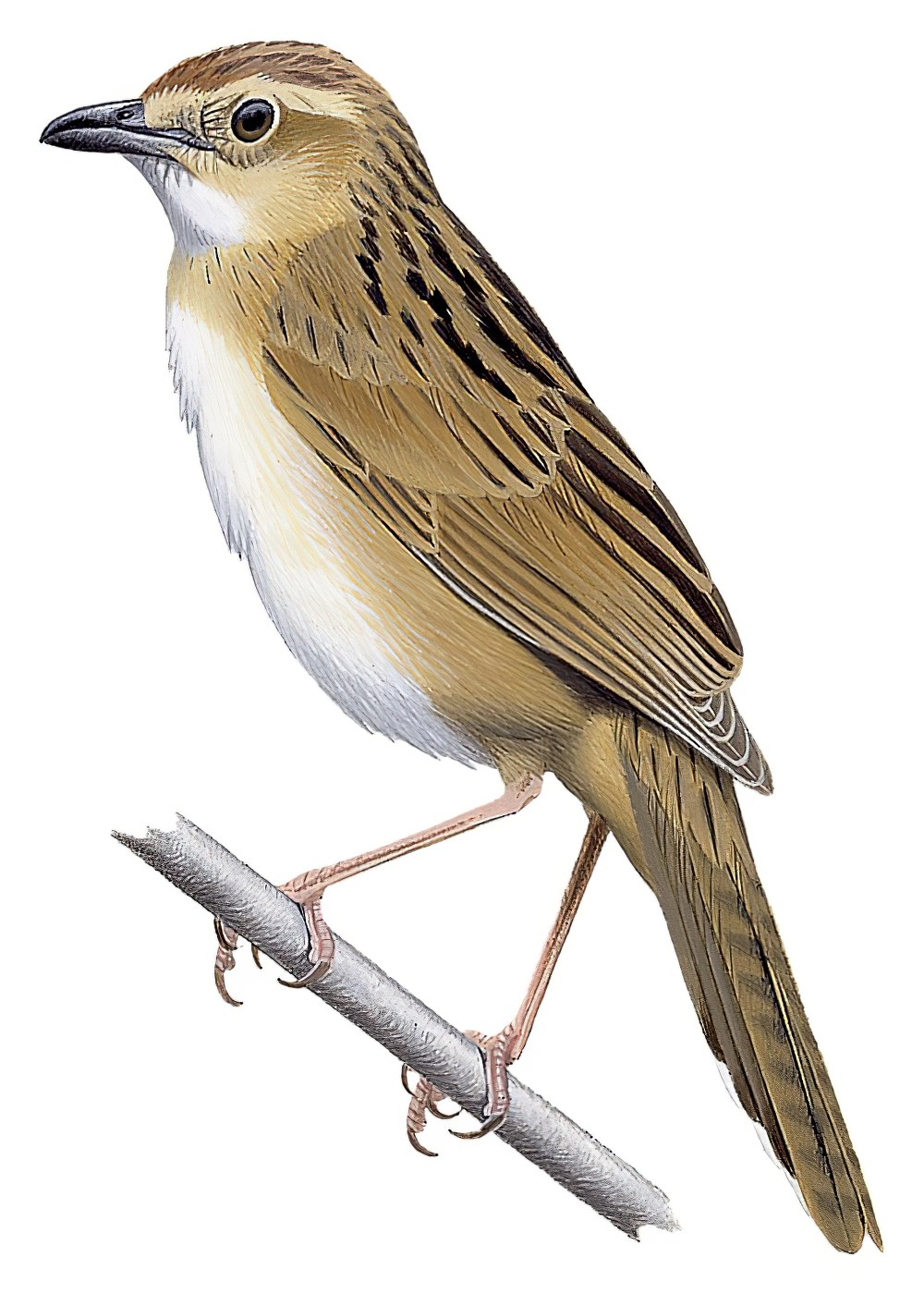Bristled Grassbird / Chaetornis striata

Bristled Grassbird
SCI Name:
Protonym: Megalurus? striatus Suppl.Cat.BirdsIndia p.88
Taxonomy: Passeriformes / Locustellidae / Chaetornis
Taxonomy Code: brigra2
Type Locality: Nilgiris.
Author: Jerdon
Publish Year: 1841
IUCN Status: Vulnerable
DEFINITIONS
CHAETORNIS
(Locustellidae; Ϯ Bristled Grassbird C. striata) Gr. χαιτη khaitē long hair; ορνις ornis, ορνιθος ornithos bird; "Characterized by having unfeathered lores with five very strong rictal bristles arranged in a vertical row in front of the eye ... These five bristles are set in a loose moveable flap of skin so that they move backwards and forwards as on a hinge. When pressed back they cover the eyes completely with a grating and afford adequate protection to them while the bird is moving through heavy rough-edged grass" (Ali & Ripley, 8, 1973); "CHÆTORNIS. Bill moderate and strong, with the culmen arched, and the sides much compressed to the tip, which is slightly emarginated; the gonys short and ascending; the gape furnished with four or five strong bristles; the nostrils basal, and placed in a membranous groove, which is partly clothed with plumes, with the opening oval and exposed. Wings rather short, and rounded; with the first quill half the length of the third; the second nearly as long as the three next, which are equal and longest. Tail lengthened, broad, and rounded. Tarsi rather shorter than the middle toe, strong, and covered with an almost entire scale in front. Toes lengthened and slender; the outer toe shorter than the inner, and slightly united at the base; the hind toe long, strong, and armed with a long, nearly straight, and acute claw. The species that compose this genus are found in India. 1. C. striata (Jerd.) Madr. Journ. Lit. & Sci. 1841. p. 198. — Dasyornis locustelloïdes Blyth. | 2. C. collurioceps (Blyth), Journ. A. S. B. 1842. p. 603." (G. R. Gray 1848); "Chaetornis G. R. Gray, 1848, Gen. Birds, 1, p. [167], pl. 48, fig. 9 [head]. Type, by original designation, Megalurus? striatus Jerdon." (Watson in Peters, XI, p. 48).
striata
L. striatus striated < striare to striate < stria furrow (see also striatus).
● ex “Blue-striped Roller” of Latham 1781 (Aplonis).
● “Tringa striata Linn., 1766, used in the former edition of the List, has been shown to refer to the Redshank and not to the Purple Sandpiper” (BOU 1915) (syn. Calidris maritima).
● ex “Choucas de la Nouvelle Guinée” of d’Aubenton 1765-1781, pl. 629, and “New-Guinea Crow” of Latham 1781 (Coracina).
● ex “Promérops de la nouvelle Guinée” of d’Aubenton 1765-1781, pl. 638, and “Promérops brun à ventre rayé” of de Buffon 1770-1783 (syn. Epimachus fastuosus).
● ex “Transverse Striped Dove” or “Barred Dove” of Edwards 1751, and “Turtur Sinensis striatus” and “Turtur Indicus striatus” of Brisson 1760 (Geopelia).
● ex “Rasle rayé des Philippines” of Brisson 1760 (Lewinia).
● ex “Gros-bec de l’Île de Bourbon” of Brisson 1760 (Lonchura).
● (Statius Müller 1776) ex “Pic rayé de St. Domingue” of d’Aubenton 1765-1781, pl. 281 (Melanerpes).
● (Boddaert 1783) ex “Picus dominicensis striatus” of Brisson 1760, and “Pic rayé de St. Domingue” of d’Aubenton 1765-1781, pl. 281 (syn. Melanerpes striatus).
● (J. Gmelin 1788) ex “Picus dominicensis striatus” of Brisson 1760, “Pic rayé de St. Domingue” of d’Aubenton 1765-1781, pl. 281, and “Rayed Woodpecker” of Latham 1782 (syn. Melanerpes striatus).
● ex “Onglet” of de Buffon 1770-1783, and “Furrow-clawed Tanager” of Latham 1783 (syn. Pipraeidea bonariensis).
● ex “Traquet à Queue Striée” of Levaillant 1806, pl. 188, fig. 1 (syn. Saxicoloides fulicatus).
● ex "Blackpoll Warbler" of Latham 1783 and Pennant 1785 (syn. Setophaga striata).
● ex “Striated Tern” of Latham 1785 (Sterna).
● ex “Totanus striatus” of Brisson 1760 (syn. Tringa totanus).
● ex “Striped-headed Finch” of Latham 1783, and “Striped Finch” of Pennant 1785 (syn. Zonotrichia albicollis).
UPPERCASE: current genus
Uppercase first letter: generic synonym
● and ● See: generic homonyms
lowercase: species and subspecies
●: early names, variants, mispellings
‡: extinct
†: type species
Gr.: ancient Greek
L.: Latin
<: derived from
syn: synonym of
/: separates historical and modern geographic names
ex: based on
TL: type locality
OD: original diagnosis (genus) or original description (species)












